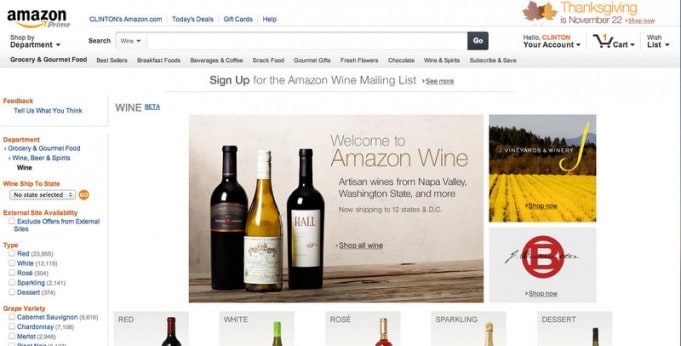Would you like two bottles of 2009 Hall Cabernet with that Kindle Fire? Well, now you’re in luck; and in just in time for the holidays too.
As widely expected, Amazon has opened its new wine marketplace. In addition to beer and spirits, consumers can now browse a new department on the Amazon web site for “artisan wines from Napa Valley, Washington State, and more.” Over 1,000 wineries across the country are already on-board.
Not everyone, however, will be able to have their J Vineyards bubbly arrive at their doorstep via Amazon. Due to a tangled web of State regulations, Amazon will initially only ship to 12 States (California, Connecticut, Florida, Iowa, Idaho, Illinois, North Carolina, New England, Nevada, Oregon, Washington and Wyoming) and D.C.
Shipping — a logistical weapon that Amazon consistently uses for competitive advantage — rings in at $9.99 for up to six bottles.
I spent a few minutes taking a look at the new wine department on the Amazon web site. Those who frequently shop on the site will find the interface immediately intuitive. A series of check boxes along the left side of the screen allow you to refine a search based on grape variety (Chardonnay, Merlot, etc.), specialty (kosher, organic), tasting notes, alcohol levels, profession ratings (sure to rile the blogosphere), vintage, brand, price point, bottle volume, and country of origin. In short, it was easy to dial in exactly the sort of wine I enjoy. I looked up Cabernets from Napa, California. Here, the limits of the early inventory were exposed. Only three bottles were on offer from that specific region: two from Porter Family Vineyards, and one from Windsor Vineyards. Broadening my horizons, I opted to see Chardonnays on offer from across the country. Results here were impressive. Bright, colorful labels from over 3,500 wines across various regions — Columbia Valley, Paso Robles, New Jersey (yep, real House Wives drink real vino), Texas, and, of course, Napa and Sonoma — lit up my Chrome browser. Hmmm, our cellar does have a few empty racks. Upon further inspection, though, I did note that many of the wines listed were those fulfilled by others and the number sold direct by Amazon far less. If I checked “Exclude Offers from External Web Sites” the total number of wines came to 1,056.
One disappointing aspect of the service is the lack of any deal for Amazon Prime customers. Those of us who who pay $79 per year (it’s also available in monthly, as-you-go payments) get to enjoy free videos, book rentals, and the famous free two-day shipping on eligible products. I must confess to being quite addicted to the service. But, it appears that us Primes will still need to pay the regular shipping rates for wine. At $9.99 flat, regardless if you buy one, three or six bottles (the maximum), it makes sense to load up as much as possible.
Another point worth noting. Although, as mentioned earlier, Amazon ships wines to twelve States and D.C., not every wine is necessarily available. For example, the 2009 Ceja Napa Carneros Chardonnay (an elegant beauty from Carneros, one of my favorite spots for Chard), only ships to six States; so it appears availability may be partially winery dependent.
With about 2.5 million shipments per year, Wine.com is likely the largest competitor. The online retailer appeared to counter Amazon’s move by unveiling its own marketplace, apparently with the goal of making it easier for consumers to source wines from small-production operations. Amazon benefits from consumers who are cross-shopping, and might in a moment of spontaneous whimsy buy a few bottles along with whatever other products (Android tablet anyone?) they happen to be browsing. Wine.com, on the other hand, will likely use its much deeper selection and sole focus on wine as key differentiators. Regarding boutique retailers, many debate the potential impact Amazon will have or not have on this niche segment. I’m not sure there will be as much as many anticipate. Those that value the high touch model, and like to get in-depth recommendations are not likely to see Amazon as a viable alternative to their corner specialist.
Will it work?
I give it a better than average chance. This is not the first time Amazon has forayed into wine sales, however, with a reportedly better integrated partnership model this go around (some wine shipments will be fulfilled directly by the wineries themselves, with a finders fee paid to Amazon), it will definitely be interesting to watch.
Now, where was I? Oh right: Kindle Fire or Nexus 7 or iPad Mini… ?


